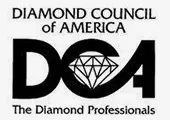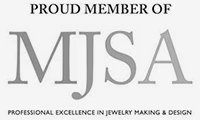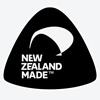Jewellery FAQ
Precious Metals
-
What type of metals does Jens Hansen use?
- We work in platinum, gold in 22ct, 18ct, 14ct and 9ct, and sterling silver. Gold alloys are available in yellow, white and rose.
-
Does any of your jewellery contain nickel?
- All of our alloys are nickel free except 14ct white gold.
-
Why do pure metals need to be mixed with other metals?
- You will find examples of jewellery made of pure metals like platinum, but pure gold is soft and not practical for daily wear. Other metals are mixed with gold to improve durability and adjust colour. Adding palladium or nickel produces white gold. Copper produces a rose tint. Silver shifts gold toward a greenish tint. Jewellery made in any of these carats is still solid gold.
- You will find examples of jewellery made of pure metals like platinum, but pure gold is soft and not practical for daily wear. Other metals are mixed with gold to improve durability and adjust colour. Adding palladium or nickel produces white gold. Copper produces a rose tint. Silver shifts gold toward a greenish tint. Jewellery made in any of these carats is still solid gold.
-
How much pure metal is in my jewellery, and how can I tell?
- The purity is shown by a stamp or hallmark on the piece.
- Platinum commonly 95 percent pure (PT950).
- Gold: 18ct is 75 percent pure (750). 14ct is 58.5 percent pure (585). 10ct is 41.7 percent pure (417). 9ct is 37.5 percent pure (375). Minimum legal standards vary by country. For example, the US recognises 10ct and the UK recognises 9ct.
- Fine silver is 99.9 percent pure (999). Sterling silver is 92.5 percent pure (925).
-
Do you use titanium or steel?
- We generally do not recommend titanium or tungsten for heirloom rings. They cannot be resized, and removal requires specialist tools. Precious-metal rings can be resized and serviced over a lifetime.
-
What kind of hallmarks does Jens Hansen use?
- Your jewellery will carry a fineness mark and our maker’s mark. Where applicable you may also see an individual craftsperson’s mark and approved New Zealand origin marks. These hallmarkings identify metal purity and origin.
-
What would be the best carat gold to use for my wedding ring?
- We usually recommend 18ct gold for daily wear. It balances purity with durability. Platinum is also an excellent choice. Silver is not recommended for wedding jewellery that will be worn every day.
-
Can I combine two or more different metals in a design?
- Yes. Yellow with white, or platinum with rose, creates a distinct look.
-
How do I keep my silver jewellery clean?
- Regular wear helps reduce tarnish. Silver darkens when left unworn or exposed to sulphur sources like hot pools. Use a silver polishing cloth or a reputable silver dip. A warm soapy wash and a soft toothbrush works for general cleaning. We are happy to sonic clean and buff your jewellery, or you can visit a reputable local jeweller.
Diamond FAQs
A diamond’s beauty comes from its cut, colour, clarity and carat. We help you compare options and choose the right stone for your design and budget.
-
What is a diamond?
- A diamond is a crystal of pure carbon formed under high pressure and temperature deep within the earth. Natural features that form during growth influence the final shape and clarity of the polished gem.
- Diamonds are the hardest natural material and rate 10 on the Mohs scale. They resist scratching, but like any crystal can chip if struck along a vulnerable point. Sensible wear and regular checks keep them looking their best.
-
Where do diamonds come from?
- Diamonds are mined in several countries, including Botswana, Canada, Russia and Australia, and are then cut and polished in global cutting centres. The market is diverse. We source cut and polished diamonds from trusted merchants to match your specifications.
-
What are the 4Cs?
- Carat: the diamond’s weight. One carat equals 0.2 grams. A well cut smaller diamond can look brighter than a larger poorly cut one.
- Cut: proportions, symmetry and polish. Cut quality has the biggest impact on sparkle.
- Clarity: the presence of natural inclusions. Grades range from Flawless to Included.
- Colour: the body colour of a white diamond on the D to Z scale, where D is colourless.
-
What is an "Ideal Cut"?
- Ideal Cut originally referred to Marcel Tolkowsky’s round brilliant proportions. Today, look for top cut grades from respected labs, paired with strong light performance. We prioritise cut because it drives brilliance.
-
How does a diamond get from the mines to the stores?
- After mining and sorting, rough diamonds are cut and polished, then sold through a range of channels to manufacturers and retailers. We buy cut and polished stones from reputable merchants to ensure quality and value for you.
-
Is a diamond a good investment?
- Diamonds often hold value over time, but prices can move with the market. We recommend choosing a diamond for its beauty and meaning first. We will help you select the best quality within your budget.
-
What is the difference between a "certified diamond" and a "non-certified diamond"?
- A certificate does not change the diamond. It documents independent grading of the 4Cs. We recommend reports from leading labs, such as GIA. Lab standards vary, so an independent report adds clarity for insurance and comparison.
-
Is it safe to receive a diamond in the mail?
- Yes. We ship with DHL, fully insured and tracked.
Gemstone FAQs
-
What is a gemstone?
- Gemstones are minerals, rocks, or organic materials used for jewellery and art. Examples include diamonds, sapphires, rubies and emeralds, as well as amethyst, citrine, garnet, tourmaline and topaz.
-
What is the difference between precious and semi-precious gemstones?
- Traditionally, diamond, ruby, emerald and sapphire were called precious, and others semi-precious. Today value depends on rarity and quality within each species. A fine tsavorite garnet, for example, can exceed a mid-grade emerald.
-
Does New Zealand have any gemstones?
- New Zealand has pounamu (jade or greenstone), paua and paua pearls, and Ruby Rock (Goodletite). These are distinct local materials used in jewellery.
-
What stones does Jens Hansen use in its jewellery?
- We work with a wide range of stones and cuts. Jens’ early designs often featured cabochons and semi-precious stones. Today we use the full spectrum of gems. We can also set your own stones, including remodelling heirloom jewellery.
-
Would a sapphire be OK to wear every day?
- Yes. Sapphires are durable and suit daily wear. Remove jewellery before bed, exercise, household chemicals and swimming. Extra care is needed with softer or more fragile stones like emeralds, opals and pearls.
-
Can I have my damaged or worn stone made to look new again?
- Often yes. A lapidary can recut or repolish chips and abrasions. Some work can be done in the setting. In other cases the stone is removed for best results. We will advise the safest approach.
-
What are the birthstones?
- January – Garnet. Many colours. Mohs ~6.5 to 7.5. Good for daily wear with care.
- February – Amethyst. Light violet to deep purple. Often set in silver and gold.
- March – Aquamarine. A blue beryl. Relatively hard but can be brittle. Bloodstone is also traditional.
- April – Diamond. Hardest natural material. Colours range from colourless to fancy hues. Black diamonds appear black due to dense inclusions.
- May – Emerald. A green beryl. Hard but often included, so protect from knocks.
- June – Pearl. Most pearls are cultured. Put on after perfume and creams. Moonstone and Alexandrite are also June birthstones.
- July – Ruby. Red corundum. Durable and ideal for daily wear.
- August – Peridot. Olive to yellow-green. Wear with care to avoid hard knocks.
- September – Sapphire. One of the hardest coloured stones. Blue, green, orange, pink and parti sapphires. Sri Lankan stones are known for vivid blues. Australia produces many dark blues and parti stones. Historic Kashmir gems from the Paddar region are exceptionally rare.
- October – Opal. Sold as solids, doublets or triplets. Doublets and triplets have glued layers and should be kept out of water and heat. Solid opals are more robust, but all opals benefit from mindful wear. Pink tourmaline is also an October birthstone.
- November – Topaz. Naturally colourless to yellow, brown, or pink. Blue topaz is commonly produced by treatment. Mystic topaz is coated to show a rainbow effect. Citrine is also a November birthstone.
- December – Zircon. Many colours. Do not confuse natural zircon with cubic zirconia, a synthetic diamond simulant. Turquoise is also a December birthstone.
-
What happens if my new piece of jewellery isn't the right size?
- Visit our Nelson studio and we will assess the best resizing method. Simple bands are often adjusted the same day. If you are overseas, a reputable local jeweller can assist, or we can arrange a return for resizing. Engraved or complex designs may require specific techniques which we will explain before work begins.
-
I’ve heard that 14 carat gold is harder, but not as rich in colour as 18 carat. What are the differences?
- 14ct is typically harder and slightly paler than 18ct because it has a lower gold content. Many people like the look and practicality of both. If you have metal sensitivities, talk to us about alloy choices in 14ct and 18ct.
-
What is the guarantee on your jewellery?
- Every piece carries our lifetime workmanship guarantee. If a workmanship defect appears, we will repair or replace it. Normal wear is expected over time and we offer cleaning, inspection and maintenance to keep your jewellery in top condition.
-
If I am having my goods shipped, do I pay customs duty and tax?
- Exports from New Zealand are not charged NZ GST, which saves you 15 percent. Duties and taxes in your country are your responsibility. DHL or your local customs office may contact you for payment or identification. Please check local rates if you need an estimate.
-
How do I pay for my purchase?
- A 25 percent deposit starts your order. The balance is due before delivery. We accept major credit cards, PayPal and direct credit. Layby is available for eligible orders.
-
How long does it take to receive my purchase?
- If the right item and size are in our studio, delivery is the standard DHL shipping time, usually 2 to 7 working days.
- If we make the item to order, allow about 1 to 3 additional weeks depending on the design. We will confirm the timeline when you order.
Sponsorships & Affiliations












